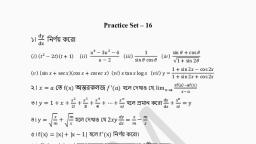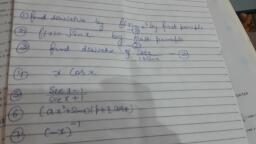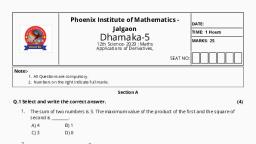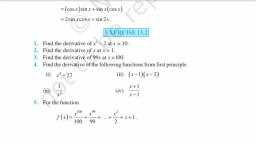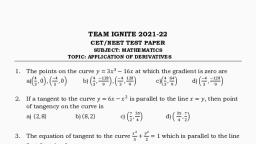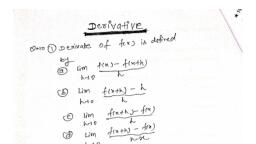Question 1 :
If the radius of a sphere is measured as $8\ cm$ with a error of $0.03\ cm$, then the approximate error calculate its volume is
Question 2 :
The side of a square sheet is increasing at the rate of $4 cm$ per minute. The rate by which the area increasing when the side is $8 cm$ long is.
Question 3 :
The sides of two squares are $x$ and $y$ respectively, such that $y = x + x^{2}$. The rate of change of area of second square with respect to area of first square is ________.
Question 4 :
The area of an equilateral triangle of side $'a'$ feet is increasing at the rate of $4 sq.ft./sec$. The rate at which the perimeter is increasing is
Question 5 :
If the displacement of a particle moving in straight line is given by $x=3t^2+2t+1$ at time $t$ then  the acceleration of the particle at time $t=3$ is
Question 6 :
The interval in which the function $x^3$ increases less rapidly than $6x^2+15x+15$ is
Question 7 :
The radius of a circle is uniformly increasing at the rate of $3cm/s$. What is the rate of increase in area, when the radius is $10cm$?
Question 8 :
If the distance $s$ travelled by a particle in time $t$ is given by $s=t^2-2t+5$, then its acceleration is
Question 9 :
A particle moves along a curve so that its coordinates at time $t$ are $\displaystyle x = t, y = \frac{1}{2} t^{2}, z =\frac{1}{3}t^{3}$ acceleration at $ t=1 $ is<br>
Question 10 :
Consider the following statements:<br/>1. $\dfrac {dy}{dx}$ at a point on the curve gives slope of the tangent at that point.<br/>2. If $a(t)$ denotes acceleration of a particle, then $\displaystyle \int a(t) dt + c$ give velocity of the particle.<br/>3. If $s(t)$ gives displacement of a particle at time $t$, then $\dfrac {ds}{dt}$ gives its acceleration at that instant.<br/>Which of the above statements is/ are correct?
Question 11 :
The rate of change of surface area of a sphere of radius $r$ when the radius is increasing at the rate of $2 cm/sec$ is proportional to
Question 12 :
What is the rate of change $\sqrt{x^2 + 16 }$ with respect to $x^2$ at x = 3 ?
Question 13 :
Excluding stoppages, the speed of a bus is $72\ kmph$ and including stoppages, it is $60\ kmph$. For how many minutes does the bus stop per hour?
Question 15 :
The interval in which the function $f(x) = {x^3}$ increases less rapidly than $\,g(x) = 6{x^2} + 15x + 5$ is :
Question 16 :
If $y = 6x -x^3$ and $x$ increases at the rate of $5$ units per second, the rate of change of slope when $x = 3$ is
Question 17 :
A particle moves along a straight line according to the law $s=16-2t+3t^3$, where $s$ metres is the distance of the particle from a fixed point at the end of $t$ second. The acceleration of the particle at the end of $2$ s is
Question 18 :
What is the rate of change of the area of a circle with respect to its radius $r$ at $r = 6$ $cm$.
Question 19 :
The position of a particle is given by $s={ t }^{ 3 }-6{ t }^{ 2 }-15t$ where $s$ in metres, $t$ is in seconds. If the particle is at rest, then time $t=.....$
Question 20 :
A ladder, 5 meter long, standing on a horizontal floor, leans against vertical wall. If the top of the ladder slides downwards at the rate of 10cm/sec, then the rate at which the angle between the floor and the ladder is decreasing when lower end of ladder is 2 metres from the wall is:
Question 21 :
The radius of a circular plate is increased at $ 0.01 \text {cm/sec}.$ If the area is increased at the rate of $\frac{\pi }{{10}}$. Then its radius is 
Question 22 :
A stone is dropped into a quiet lake and waves move in circles at the speed of $5$ cm/s At the instant when the radius of the circular wave is $8$ cm how fast is the enclosed area increasing?<br/>
Question 23 :
The distance moved by the particle in time t is given by $x = t^3 - 12t^2 + 6t + 8$. At the instant when its acceleration is zero, the velocity is
Question 24 :
A cube of ice melts without changing its shape at the uniform rate of $4\>cm^3/min$. The rate of change of the surface area of the cube, in $cm^2/min$, when the volume of the cube is $125\>cm^3$, is
Question 25 :
A man on a wharf 12 mt above the water level pulls in a rope to which a boat is attached at the rate of $1$ mt per second. At what rate is the boat approaching the shore, when there is still $13$ mt rope out ?
Question 26 :
Find the equation of the quadratic function $f$ whose graph increases over the interval $(-\infty, -2)$ and decreases over the interval $(-2,+\infty)$, $f(0)=23$ and $f(1)=8$
Question 27 :
The equation of a stationary wave is $y = 4\sin \frac{\pi x}{5} \cos (100 \pi t)$. The wave is formed using a string of length $20cm$. The second and 3rd antinodes are located at positions (in cm)
Question 28 :
A particular point moves on the parabola $y^2=4ax $ in such a way that its projection on $y$-axis has a constant velocity. Then its projection on $x$-axis moves with
Question 30 :
A spherical iron ball $10$ cm in radius is coated with a layer of ice of uniform thickness that melts at a rate of $50$ cm$^{3}$/min. When the thickness of ice is $5$ cm, then the rate at which the thickness of ice decreases, is<br/>
Question 31 :
Two measurements of a cylinder are varying in such a way that the volume is kept constant. If the rates of change of the radius $(r)$ and height $(h)$ are equal in magnitude but opposite in sign, then
Question 32 :
If $20$% of a radioactive substance disappears in $1$ year, then its half life approximately equal to
Question 33 :
If a point is moving in a line so that its velocity at time t is proportional to the square of the distance covered, then its acceleration at time t varies as
Question 34 :
The coordinates of the point on the ellipse $16x^2 + 9y^2 = 400$ where the ordinate decrease at the same rate at which the abscissa increases, are
Question 35 :
A point is moving along the curve$\displaystyle y^3 = 27x$. The interval in which the abscissa changes at slower rate than ordinate, is
Question 36 :
If $x\sqrt{1+y} + y\sqrt{1+x} = 0$ and $x \neq y $ then $\dfrac{dy}{dx} = $
Question 37 :
The sides of an equilateral triangle are increasing at the rate of $2{ cm }/{ s }$. The rate at which the area increases when the side is $10 cm$, is
Question 38 :
The radius of a circle is increasing at the rate of $0.7\cm/s$. What is the rate of increase of its circumference ?
Question 39 :
If a circular plate is heated uniformly, its area expands $3c$ times as fast as its radius, then the value of $c$ when the radius is $6$ units, is
Question 40 :
The edge of a cube is equal to the radius of a sphere. If the edge and the radius increase at the same rate, then the ratio of increase in surface areas of the cube and sphere is
Question 41 :
The side of a square sheet is increasing at the rate of $4\ cm$ per minute. The rate by which the area increasing when the side is $8\ cm$ long is-
Question 42 :
For what values of $ x$ is the rate of increase of $x^3 - 5x^2 + 5x +8$ is twice the rate of increase of $x$?
Question 43 :
Sand is pouring from a pipe at the rate of $12$ cc/sec. The falling sand forms a cone on the ground in such a way that the height of the cone is always $\dfrac {1}{6}^{th}$ of the radius of the base How fast is the height of the sand cone increasing when the height is $4$ cm.
Question 44 :
The velocity $v$ of a particle moving along a straight line and its distance $s$ from a fixed point on the line are related by $ v^2 = a^2 + s^2$, then its acceleration equals
Question 45 :
A particle moves along the curve $y = x^2 + 2x$. Thenthe points on the curve are the x and y coordinatesof the particle changing at the same rate, are.
Question 47 :
The motion of a particle along a straight line is described by equation<br/><br/>$x = 8 + 12t t^{3}$<br/><br/>where x is in metre and t in second. The retardation of the particle when its velocity becomes zero is<br/>
Question 48 :
If the volume of a spherical ball is increasing at the rate of $4\pi\ cc/sec$, then the rate of increase of its radius (in cm/sec), when the volume is $288\pi\ cc$, is 
Question 49 :
If the distance '$s$' metres transversed by a particle in $t$ seconds is given by $\displaystyle s={ t }^{ 3 }-3{ t }^{ 2 }$, then the velocity of the particle when the acceleration is zero, in metre/sec is
Question 50 :
A particle moves along a straight line and its velocity at a distance 'x' from the origin is $k\sqrt{a^2-x^2}$. Then acceleration of the particle is
Question 51 :
A point on the parabola $\mathrm{y}^{2}=18\mathrm{x}$ at which the ordinate increases at twice the rate of the abscissa is: <br/>
Question 52 :
Side of an equilateral triangle expands at the rate of $2 cm/sec$. The rate of increase of its area when each side is $10cm$ is
Question 53 :
A spherical balloon is being inflated so that its volume increase uniformly at the rate of $40cm^3 /minute$. The rate of increase in its surface area when the radius is $8 cm$ is
Question 54 :
A point is in motion along a hyperbola $y=\dfrac{10}{x}$ so that its abscissa x increases uniformly at rate of $1$ unit per second. Then, the rate of change of its ordinate, when the point passes through $(5, 2)$.
Question 55 :
Water runs into an inverted conical tent at the rate of $20\:{ft}^3/min$ and leaks out at the rate of$5\:{ft}^3/min$. The height of the water is three times the radius of the water's surface. The radius of the water surface is increasing when the radius is $5\:ft$, is
Question 56 :
If $f'\left( x \right) = \sqrt {2{x^2} - 1} $ and $y = f\left( {{x^2}} \right)$, then $\frac{{dy}}{{dx}}$ at $x = 1$ is equal to
Question 57 :
If a particle moving along a line follows the law $t=as^2 + bs+c$, then the retardation of the particle is proportional to
Question 58 :
Half of a large cylindrical tank open at the top is filled with water and identical heavy spherical balls are to be dropped into the tank without spilling water out. If the radius and the height of the tank are equal and each is four times the radius of a ball, what is the maximum number of balls that can be dropped?
Question 59 :
The equation of motion of a particle moving along a straight line is $s=2t^3-9t^2+12t$, where the units of s and t are centimetre and second. The acceleration of the particle will be zero after.
Question 60 :
The population $p(t)$at time t of a certain mouse species satisfies the differential equation $\dfrac { dp\left( t \right) }{ dt } =0.5p\left( t \right) -450. $ If $p\left( 0 \right) =850,$ then the time at which the population becomes zero is:
Question 61 :
A particle moves in a line with velocity given by $\dfrac{ds}{dt}=s+1$. The time taken by the particle to cover a distance of $9$ meter is
Question 62 :
The acceleration of a particle starting from rest moving in a straight line with uniform acceleration is $8m/{s}^{2}$. The time taken by the particle to move the second metre is
Question 63 :
An open cylindrical can of given capacity is to be made from a metal sheet of uniform thickness. If no allowance is to be made for waste material, what will be the most economical ratio of the radius to the height of the can ?
Question 64 :
A cylindrical gas container is closed at the top and open at the bottom; if the iron plate of the top is $5/4$ times as thick as the plate forming the cylindrical sides, find the radio of the radius to the height of the cylinder using minimum material for the same capacity.
Question 65 :
An object stars from rest at $t=0$ and accelerates at a rate given by $a=6t$. What i) its velocity and ii) its displacement at any time $t$?
Question 66 :
The weight $W$ of a certain stock of fish is given by $W = nw$, where $n$ is the size of stock and $W$ is the average weight of a fish. If $n$ and $w$ change with time $t$ as $n = 2t^2 +3$ and $w= t^2 - t + 2$, then the rate of change of $W$ with respect to $t$ at $t = 1$ is
Question 67 :
A spherical balloon is being inflated so that its volume increases uniformly at the rate of $ 40 cm^3/min. $ At $r=8 cm$, its surface area increases at the rate
Question 68 :
The distance moved by the particular in time $t$ is given by $s = t^{3} - 12t^{2} + 6t + 8$. At the instant, when its acceleration is zero the velocity is
Question 69 :
A dynamite blast blows a heavy rock straight up with a launch velocity of $160$  $m/sec$. It reaches a height of $s= 160t\, -\, 16t^{2}$ after $t$ $sec$. The velocity of the rock when it is $256$ $m$ above the ground on the way up is<br/>
Question 70 :
The radius of a cylinder is increasing at the rate of $5$ cm/min so that its volume is constant. When its radius is $5$ cm and height is $3$ cm, then the rate of decreasing of its height is
Question 71 :
If the volume of spherical ball is increasing at the rate of $4\pi \ cc/sec$ then the rate of change of its surface area when the volume is $288\pi cc$ is
Question 72 :
A point is moving along the curve $\displaystyle y^{3}=27x$The interval in which the abscissa changes at slower rate than ordinate is
Question 73 :
A variable triangle $ABC$ is inscribed in a circle of diameter $x$ units. If at a particular instant the rate of change of side, '$a$' is $x/2$ times the rate of change of the opposite angle $A$, then $A$ =
Question 74 :
If the rate of change in $y=\dfrac {x^ {3}}{3}-2x^ {2}+5x+7$ is two times the rate of change in $x$, then $x=$
Question 75 :
A balloon which always remains spherical is being inflated by pumping in $10$ cubic centimeters of gas per second. Find the rate at which the radius of the balloon is increasing when the radius is $15\ cms$
Question 76 :
$N$ characters of information are held on magnetic tape, in batches of $x$ characters each; the batch processing time is $\alpha +\beta { x }^{ 2 }$ seconds; $\alpha ,\beta $ are constants. The optimum value of $x$ for fast processing is
Question 77 :
Let $S$ be the focus of $y^2 = 4x$ and a point $P$ is moving on the curve such that its abscissa is increasing at the rate of $4$ units/sec, then the rate of increase of projection of $SP$ on $x + y = 1$ when $P$ is at $(4, 4)$ is
Question 78 :
The radius of the base of a cone is increasing at the rate of $3$ cm/minute and thealtitude is decreasing at the rate of $4$ cm/minute. The rate of change of lateral surface when the radius is $7 cm$ and altitude $24 cm$ is
Question 79 :
The radius of a cylinder is increasing at the rate of $3m/s$ and its altitude is decreasing at the rate of $4m/s$. The rate of change of volume when radius is $4m$ and altitude is $6m$ is
Question 80 :
<span class="wysiwyg-font-size-small"><span class="wysiwyg-font-size-small">A certain radioactive material is known to decay at a rate proportional to the amount present. Initially there is 50 kg of the material present and after two hours it is observed that the material has lost 10%of its original mass, then the
Question 81 :
Initially, equation of ellipse was $3x^2+4y^2=12$. Keeping major axis constant, ellipse is bulge to form circle (with major axis as diameter). Its eccentricity changes at a rate $0.1/$sec. Time taken to form this circle is
Question 82 :
A balloon is pumped at the rate of a cm$^{3}$/minute. The rate of increase of its surface area when the radius is b cm, is
Question 83 :
If $ f(x) =\displaystyle\frac{x}{{\sin x}}$ and $g(x) =\displaystyle\frac{x}{{\tan x}}$ where $0 < x \leq1$<span class="wysiwyg-font-size-medium">then in the interval<span class="wysiwyg-font-size-medium">
Question 84 :
A body travels a distance $s$ in $t$ seconds. It starts from rest and ends at rest. In the first part of the journey, it move with constant acceleration $f$ and in the seconds part with constant retardation $r$. The value of $t$ given by
Question 85 :
A particle moves along the y-axis so that its position at time $0\leq t\leq 20$ is given by $y(t) = 5t - \dfrac {t^{2}}{3}$. At what time does the particle change direction?
Question 86 :
At what rate is the radius of the water surface changing when the water is 8 m deep
Question 87 :
On the curve ${x}^{3} = 12y$ , then the interval at which the abscissa changes at a faster rate than the ordinate ?<br/>
Question 88 :
A particle moves along the curve $\displaystyle y=x^{3/2}$in the first quadrant in such a way that its distance from the origin increases at the rate of 11 units per second. The value of when x = 3 is
Question 89 :
A man is moving away from a tower 41.6 m high at a rate of 2 m/s. If the eye level of the man is 1.6 m above the ground, then the rate at which the angle of elevation of the top of the tower changes, when he is at a distance of 30 m from the foot of the tower, is
Question 90 :
The two tangents to the curve $ax^2 + 2hxy + by^2 = 1, a > 0$ at the points where it crosses the X-axis, are
Question 91 :
Find the max.value of the total surface of a right circular cylinder which can be inscribed in a sphere of radius a.
Question 92 :
The distance (in metre) travelled by a vehicle in time $t$ (in seconds) is given by the equation $s={ t }^{ 3 }+2{ t }^{ 2 }+t+1$. The difference in the acceleration between $t=2$ and $t=4$ is
Question 93 :
The points of the ellipse $16x^2 + 9y^2 = 400$ at which the ordinate decreases at the same rate at which the abscissa increases is/are given by :
Question 94 :
The surface area of sphere when the volume is increasing at the same rate as its radius is:
Question 95 :
A point on the parabola ${ y }^{ 2 }=18x$ at which the ordinate increases at twice the rate of the abscissa is
Question 96 :
Coffee is coming out from a conical filter, with height and diameter both $25\:cm$ into a cylindrical coffee pot with diameter $15\:cm$. The constant rate at which coffee comes out from the filter into the pot is $100\:{cm}^3/min$. The rate in $cm/min$ at which the level in the pot is rising at the instance when the coffee in the pot is $10\:cm$, is
Question 97 :
The rate at which ice-ball melts is proportional to the amount of ice in it. If half of it melts in $20$ minutes, the amount of ice left after $40$ minutes compared to it original amount is
Question 98 :
A point moves along the curve $12y=x^3$ in such a way that the rate of increase of its ordinate is more than the rate of increase of abscissa. The abscissa of the point lies in the interval
Question 99 :
For particle moving along $x-axis$, velocity is given as a function of time as $v=2t^{2}+\sin t$. At $t=0$, particle is at origin, if the position as a function of time is $\dfrac{2t^{3}}{m}-\cos t$, then find $m$.
Question 100 :
$x$ and $y$ are the sides of two squares such that$y=x-x^{2}$. The rate of change of the area of the second square with respect to that of the first square is
Question 101 :
Let $I$ be the purchase value of an equipment and $v(t)$ be the value after it has been used for $t$ years. The value $V(t)$ depreciates at a rate given by differential equation $\displaystyle \frac{\mathrm{d}\mathrm{V}(\mathrm{t})}{\mathrm{d}\mathrm{t}}=-\mathrm{k}(\mathrm{T-t})$, where $\mathrm{k}>0$ is a constant and $\mathrm{T}$ is the total life in years of the equipment. Then the scrap value $v(T)$ of the equipment is<br><br>
Question 102 :
It is desired to construct a cylindrical vessel of capacity 500 cubic metres open at the top.What should be the dimensions of the vessel so that the material need is minimum, given that the thickness of the material used is 2 cm.

